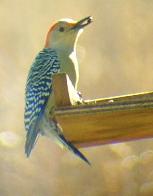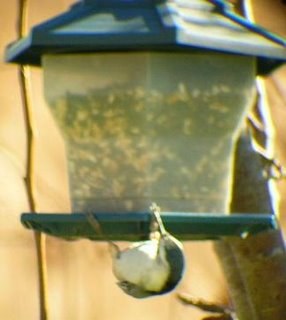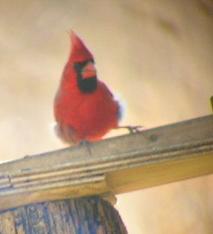The birds, probably just as happy as I was to see the sun, cooperated and took their places at the feeding stations. I set up to watch the platform feeder on the back fence with the scope, later moving it to watch the hanging feeder. I watched the suet feeder with my eyes and my binocs.
My first shot through the scope:
 No, it wasn't night time. This is just that bad. There's a little sparrow in that blackness, sitting on the platform feeder.
No, it wasn't night time. This is just that bad. There's a little sparrow in that blackness, sitting on the platform feeder.Clearly, some adjustment was necessary.
I backed off the zoom on the scope (it goes 20-60X), backed off the zoom on the camera (the Nikon CP4800), and repositioned. Mr. Cardinal allowed this photograph of his somewhat moult-y form:
Certainly an improvement, but the focus still wasn't too good. Also, vignetting was a big problem:
 After some experimentation, I found that zooming the scope only a little bit cut the vignetting almost completely for my eye, but it only improved it somewhat for the camera. I think the problem lies in the camera lens, which is set back in the camera body. When I zoom, the barrel comes way out, and it seems the lens is even farther from the scope's eyepiece than before. So the camera was not zoomed at all for the rest of the photos; the scope was mainly on about 25-30X zoom. Further, I have no adapter, so I'm just holding the camera's lens to the scope with my left hand. Conditions were full sun, somewhat backlighting the subjects from directly behind and then slightly to the right but still behind as the sun travelled its in low winter arc across the sky.
After some experimentation, I found that zooming the scope only a little bit cut the vignetting almost completely for my eye, but it only improved it somewhat for the camera. I think the problem lies in the camera lens, which is set back in the camera body. When I zoom, the barrel comes way out, and it seems the lens is even farther from the scope's eyepiece than before. So the camera was not zoomed at all for the rest of the photos; the scope was mainly on about 25-30X zoom. Further, I have no adapter, so I'm just holding the camera's lens to the scope with my left hand. Conditions were full sun, somewhat backlighting the subjects from directly behind and then slightly to the right but still behind as the sun travelled its in low winter arc across the sky.I then heard a strange call and was stunned to see my first red-bellied woodpecker! I got a lot of blurry shots, but this is a fairly clear one:

 Of course at first, I was so freaked out by this lifebird that I took a video, but I don't know how to load those onto Blogger and I dare not just try loading it like a photo on my dial-up connection! Let's move on:
Of course at first, I was so freaked out by this lifebird that I took a video, but I don't know how to load those onto Blogger and I dare not just try loading it like a photo on my dial-up connection! Let's move on: I love the rumps of bluejays--so many shades of blue all together. Bluejays are mean and they tend to hog the feeder, but they're beautiful. At one point when I was just watching through the scope, the red-bellied was sitting on the platform and a jay tried to land, but the red-bellied opened his mouth and shooed the jay away--I didn't really hear a sound from the open mouth, but it was a clear "Hey, wait your turn!"
I love the rumps of bluejays--so many shades of blue all together. Bluejays are mean and they tend to hog the feeder, but they're beautiful. At one point when I was just watching through the scope, the red-bellied was sitting on the platform and a jay tried to land, but the red-bellied opened his mouth and shooed the jay away--I didn't really hear a sound from the open mouth, but it was a clear "Hey, wait your turn!"The infamous American goldfinch in winter plumage showed up and offered this pose:

Look at his pretty little pink feet.
This little sparrow stopped in a for a bite:
 I haven't heard the distinctive song sparrow call since the summertime, so I began to think they'd all flown south. However, after really trying to look at all the details in the photo and in Peterson's, I'm certain this is a song sparrow, though I never got to see his breast to look for the large central spot that Peterson points out. But the streaking on his sides, as well as the lack of white outer tail feathers (vesper sparrow), makes me sure this is a song sparrow. Not to make a big deal of a pretty simple ID, but I'm trying to learn to focus on key ID elements so I don't make as many mistakes with the more difficult IDs.
I haven't heard the distinctive song sparrow call since the summertime, so I began to think they'd all flown south. However, after really trying to look at all the details in the photo and in Peterson's, I'm certain this is a song sparrow, though I never got to see his breast to look for the large central spot that Peterson points out. But the streaking on his sides, as well as the lack of white outer tail feathers (vesper sparrow), makes me sure this is a song sparrow. Not to make a big deal of a pretty simple ID, but I'm trying to learn to focus on key ID elements so I don't make as many mistakes with the more difficult IDs.The sparrow was soon joined by a male house finch:


I tried to zoom in on the house finch to look for conjunctivitis, but if he had it, he had only a minor case. The photos on the Project Feederwatch site all look so severe--but the house finches I saw this morning looked okay. If you can see something I don't see, please let me know, so I can make a correct entry in my Feederwatch weekend report.
The white-breasted nuthatch came back a few times, stopping at both the hanging feeder and the suet block:
 What an acrobat!
What an acrobat!That's the extent of the decent photos. I also saw but didn't get even bad photos of the following:
1. some kind of wren, I think. This is the first time I've seen this bird; it was rusty-colored, with a flat tail that reflected sunlight in the most beautiful way. He had the nuthatch's style of creeping close to the tree trunks and fence posts, and he spent a good deal of time perusing the brush piles. Peterson says to look for the tail cocked up over the back, but I didn't see him do that at all. Still, he looked most like a Carolina wren as opposed to a house wren or long-billed marsh wren. I considered his very rusty color and distinctive white eye stripe, plus the lack of striping on the back. Further, Peterson describes this wren as prefering "tangles and brushy undergrowth--he definitely did that. Also he explored a small cavity in a fence post right near one of the brush piles:
 Still, I'm not as certain about this ID, because of the lack of tail-cocking. Everything else, however, tells me it was a Carolina wren.
Still, I'm not as certain about this ID, because of the lack of tail-cocking. Everything else, however, tells me it was a Carolina wren.2. the downy woodpecker, who made his regular appearance at the suet feeder. In Peterson, it seems the only differences between the downy and the hairy are body size and bill length (hairy is bigger with longer beak). One thing Peterson doesn't do in his first edition is show the female downy or hairy; only the males with their red caps near the backs of their heads. However, I've seen a woody with no red spot, larger than the male downy I've seen. I noted a distinct white-and-black pattern (Fig 1 and 2) on her crown and nape (trying to use the right terms here). I thought at first, due to the larger size, that I might have a female hairy. I looked at some other photos and drawings, and I really can't tell which she is. Judging from the fact that she's bigger than the male downy I've seen, I'm going to offer a 50/50 guess that she is a hairy woodpecker. Any help, anyone?
3, 4, 5. several kinds of sparrows. I believe I ID'd white-throated (easy to tell), field (rusty cap, no stickpin marking on breast, no white eyebrow stripe--though I forgot to check color of beak), and swamp (rusty cap, white throat, grayish breast). Wish I had photos of all of them, but most of the time they were on the ground. I need to get that log feeder made so I can get a better view of the ground-feeders.
6. black-capped chickadee. I love their songs and calls.
7. northern mockingbird
8. eastern phoebe, though I only heard this bird--I've heard it a million times but only today did it finally click that the sound was indeed "fee-bee" and it was an eastern phoebe. I'm slow sometimes.
9. a very big raptor, who flew over the marsh a couple of times but never close enough or in good enough light (or rather too much light--he was backlit the whole time by a very bright sun). Peterson offers some silhouettes and views from below, but honestly--all I remember is that it was huge and brown. I've done a lot of work on learning about songbirds, but the raptors have pretty much eluded me, other than the red-tailed hawk whom I can identify pretty easily as long as I see him perched. On this bird, however, I just don't remember the width of the tail, and I didn't see any color other than brown on top and black (from the backlighting) on the bottom.
It was quite a morning overall, and I'm feeling pretty good right now. I'm learning how to take photos through this new scope, which I haven't decided whether I'll keep or not, and I saw two lifebirds. Pretty cool.

2 comments:
A friend of mine has introduced me to birding, so I've taken more notice of birds than ever. The second bird you saw, with the varied colors, is magnficent. I can't believe you see these kinds of birds where you live.
It's amazing how many cool birds there are almost year-round in Central PA. It's been a real thrill, getting to see these wild birds just right there in my backyard.
Post a Comment